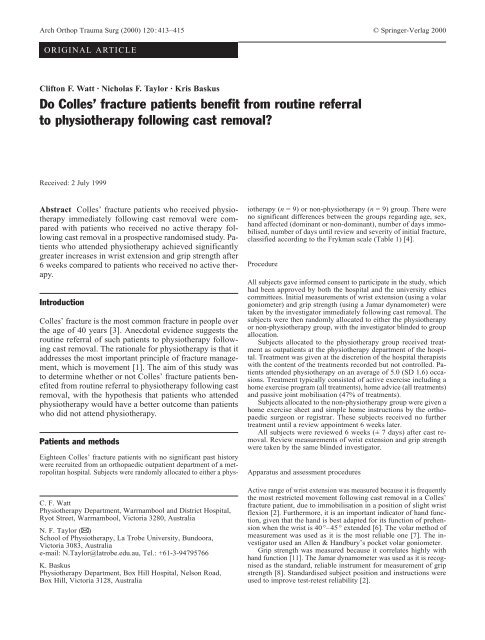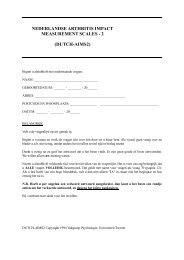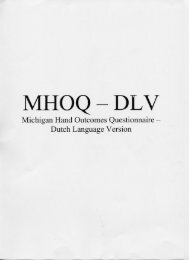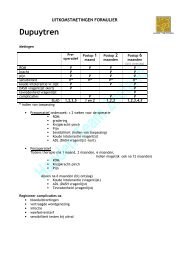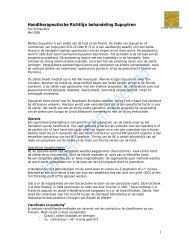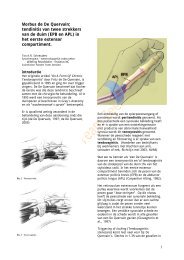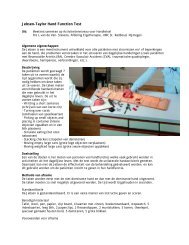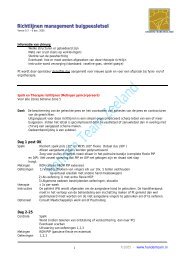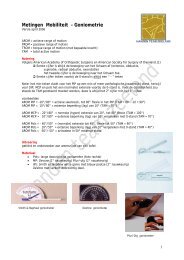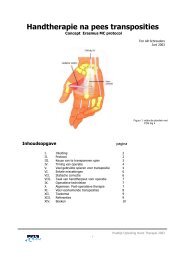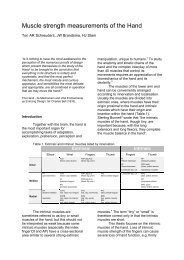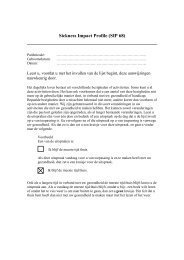Do Colles' fracture patients benefit from routine referral to ...
Do Colles' fracture patients benefit from routine referral to ...
Do Colles' fracture patients benefit from routine referral to ...
You also want an ePaper? Increase the reach of your titles
YUMPU automatically turns print PDFs into web optimized ePapers that Google loves.
Arch Orthop Trauma Surg (2000) 120 :413–415 © Springer-Verlag 2000ORIGINAL ARTICLEClif<strong>to</strong>n F. Watt · Nicholas F. Taylor · Kris Baskus<strong>Do</strong> Colles’ <strong>fracture</strong> <strong>patients</strong> <strong>benefit</strong> <strong>from</strong> <strong>routine</strong> <strong>referral</strong><strong>to</strong> physiotherapy following cast removal?Received: 2 July 1999Abstract Colles’ <strong>fracture</strong> <strong>patients</strong> who received physiotherapyimmediately following cast removal were comparedwith <strong>patients</strong> who received no active therapy followingcast removal in a prospective randomised study. Patientswho attended physiotherapy achieved significantlygreater increases in wrist extension and grip strength after6 weeks compared <strong>to</strong> <strong>patients</strong> who received no active therapy.IntroductionColles’ <strong>fracture</strong> is the most common <strong>fracture</strong> in people overthe age of 40 years [3]. Anecdotal evidence suggests the<strong>routine</strong> <strong>referral</strong> of such <strong>patients</strong> <strong>to</strong> physiotherapy followingcast removal. The rationale for physiotherapy is that itaddresses the most important principle of <strong>fracture</strong> management,which is movement [1]. The aim of this study was<strong>to</strong> determine whether or not Colles’ <strong>fracture</strong> <strong>patients</strong> <strong>benefit</strong>ed<strong>from</strong> <strong>routine</strong> <strong>referral</strong> <strong>to</strong> physiotherapy following castremoval, with the hypothesis that <strong>patients</strong> who attendedphysiotherapy would have a better outcome than <strong>patients</strong>who did not attend physiotherapy.Patients and methodsC. F. WattPhysiotherapy Department, Warrnambool and District Hospital,Ryot Street, Warrnambool, Vic<strong>to</strong>ria 3280, AustraliaN. F. Taylor ()School of Physiotherapy, La Trobe University, Bundoora,Vic<strong>to</strong>ria 3083, Australiae-mail: N.Taylor@latrobe.edu.au, Tel.: +61-3-94795766K. BaskusPhysiotherapy Department, Box Hill Hospital, Nelson Road,Box Hill, Vic<strong>to</strong>ria 3128, AustraliaEighteen Colles’ <strong>fracture</strong> <strong>patients</strong> with no significant past his<strong>to</strong>rywere recruited <strong>from</strong> an orthopaedic outpatient department of a metropolitanhospital. Subjects were randomly allocated <strong>to</strong> either a physiotherapy(n = 9) or non-physiotherapy (n = 9) group. There wereno significant differences between the groups regarding age, sex,hand affected (dominant or non-dominant), number of days immobilised,number of days until review and severity of initial <strong>fracture</strong>,classified according <strong>to</strong> the Frykman scale (Table 1) [4].ProcedureAll subjects gave informed consent <strong>to</strong> participate in the study, whichhad been approved by both the hospital and the university ethicscommittees. Initial measurements of wrist extension (using a volargoniometer) and grip strength (using a Jamar dynamometer) weretaken by the investiga<strong>to</strong>r immediately following cast removal. Thesubjects were then randomly allocated <strong>to</strong> either the physiotherapyor non-physiotherapy group, with the investiga<strong>to</strong>r blinded <strong>to</strong> groupallocation.Subjects allocated <strong>to</strong> the physiotherapy group received treatmentas out<strong>patients</strong> at the physiotherapy department of the hospital.Treatment was given at the discretion of the hospital therapistswith the content of the treatments recorded but not controlled. Patientsattended physiotherapy on an average of 5.0 (SD 1.6) occasions.Treatment typically consisted of active exercise including ahome exercise program (all treatments), home advice (all treatments)and passive joint mobilisation (47% of treatments).Subjects allocated <strong>to</strong> the non-physiotherapy group were given ahome exercise sheet and simple home instructions by the orthopaedicsurgeon or registrar. These subjects received no furthertreatment until a review appointment 6 weeks later.All subjects were reviewed 6 weeks (± 7 days) after cast removal.Review measurements of wrist extension and grip strengthwere taken by the same blinded investiga<strong>to</strong>r.Apparatus and assessment proceduresActive range of wrist extension was measured because it is frequentlythe most restricted movement following cast removal in a Colles’<strong>fracture</strong> patient, due <strong>to</strong> immobilisation in a position of slight wristflexion [2]. Furthermore, it is an important indica<strong>to</strong>r of hand function,given that the hand is best adapted for its function of prehensionwhen the wrist is 40 °–45 ° extended [6]. The volar method ofmeasurement was used as it is the most reliable one [7]. The investiga<strong>to</strong>rused an Allen & Handbury’s pocket volar goniometer.Grip strength was measured because it correlates highly withhand function [11]. The Jamar dynamometer was used as it is recognisedas the standard, reliable instrument for measurement of gripstrength [8]. Standardised subject position and instructions wereused <strong>to</strong> improve test-retest reliability [2].
414Table 1 Subjects’ demographicsTreatment groupPhysiotherapyNon-physiotherapyAge (years) (SD) 74.4 (10.2) 77.3 (5.1)Sex (M :F) 0:9 1:8Hand affected 5:4 4:5(dominant :non-dominant)Number of days 43.9 (4.4) 43.3 (5.1)immobilised (SD)Number of days until 44.2 (5.9) 41.4 (4.6)review (SD)Frykman classification 2 × I, 0 × II, 0 × III, 1 × IV, 1 × I, 1 × II, 2 × III, 1 × IV,(I–VIII) 1 × V, 0 × VI, 3 × VII, 2 × VIII 2 × V, 0 × VI, 0 × VII, 2 × VIIIData analysisA split plot analysis of variance (SPANOVA) was used <strong>to</strong> comparethe change in range of movement of active wrist extension, expressedin degrees, in the physiotherapy and non-physiotherapygroups. This comparison was made by evaluating the interaction(AB) effect.Data collected for grip strength in kilograms force failed <strong>to</strong> meetthe assumption of homogeneity of variance, and therefore the samedata analysis could not be used. A Mann-Whitney U-test was employed<strong>to</strong> compare the change scores (final strength minus initialstrength) for the two groups. The Mann-Whitney U-test is the nonparametricequivalent <strong>to</strong> a t-test carried out on the change scores,which is mathematically equivalent <strong>to</strong> the AB interaction effect determinedusing a SPANOVA [12].One-tailed tests were used for both the analysis of change instrength and change in range of wrist extension. The level of significancewas set at P = 0.05.ResultsWrist extensionThe increase in wrist extension between the initial measurementand the 6-week follow-up was significantly greaterin the physiotherapy group (Fig.1).Fig. 2 Initial and final mean grip strength for the physiotherapyand non-physiotherapy groups. The median (interquartile range) isdenoted at the bot<strong>to</strong>m of the figure. Small circles represent outlierswhich failed <strong>to</strong> fall within the 10th and 90th percentiles, denotedby error bars. The extremities of the boxes represent the 25th and75th percentiles, sometimes referred <strong>to</strong> as the interquartile range,and the solid line inside the box represents the medianGrip strengthThe increase in grip strength between the initial measurementand the 6-week follow-up was significantly greaterin the physiotherapy group (Fig.2).DiscussionFig. 1 Initial and final mean wrist extension for the physiotherapyand non-physiotherapy groups. Standard deviation denoted by errorbars. Mean and standard deviation for each group denoted atthe bot<strong>to</strong>m of the figureOur results suggest that <strong>routine</strong> <strong>referral</strong> of Colles’ <strong>fracture</strong><strong>patients</strong> <strong>to</strong> physiotherapy following cast removal is beneficial.The greater increase in wrist extension and gripstrength in those <strong>patients</strong> receiving physiotherapy was clinicallysignificant given that the <strong>fracture</strong>s were at the stageof consolidation of <strong>fracture</strong> healing [1]. At this stage <strong>patients</strong>may recommence all hobbies and return <strong>to</strong> heaviermanual work. Subjects who did not attend physiotherapywould have found many of these tasks difficult due <strong>to</strong> lackof the necessary wrist extension and grip strength requiredfor optimal prehension. However, subjects who attendedphysiotherapy possessed the necessary wrist extension andgrip strength, making the transition <strong>to</strong> such activitiesmuch easier.
Although not the primary aim of the study, we hypothesisethat the physiotherapy group did better than the nonphysiotherapygroup because they <strong>benefit</strong>ed <strong>from</strong> reinforcemen<strong>to</strong>f both home advice and active exercise. Suchreinforcement included clinical reasoning on the part ofthe treating therapist which incorporates decision-making,problem-solving and making clinical judgements [5]. Aprevious study failed <strong>to</strong> find any <strong>benefit</strong> <strong>from</strong> the additionof passive joint mobilisation <strong>to</strong> physiotherapy for Colles’<strong>fracture</strong> <strong>patients</strong> following cast removal [13]. There is aneed for further investigation <strong>to</strong> determine the importantcomponents of physiotherapy in Colles’ <strong>fracture</strong> rehabilitation.Past studies that have compared physiotherapy <strong>to</strong> nophysiotherapy in Colles’ <strong>fracture</strong> <strong>patients</strong> have shown nodifference in outcome [9, 10]. Pasila et al. [10] analysed96 <strong>patients</strong> <strong>to</strong> determine whether recovery was hastenedwhen exercise was supervised by a physiotherapist. No statisticaldifference could be detected. However, this wasexercise of the non-involved joints during the period ofimmobilisation. Hence, these exercises could not have beenexpected <strong>to</strong> influence the range of movement around thewrist following cast removal.Oskarsson et al. [9] compared supervision by physiotherapists,starting 4–6 weeks after cast removal, with selftrainingin 110 Colles’ <strong>fracture</strong> <strong>patients</strong>. Despite their conclusionthat physiotherapy subjects had the same outcomeas non-physiotherapy subjects, inspection of their raw datatable demonstrated that subjects in the physiotherapy groupshowed a greater increase (P = 0.01) in wrist movementthan subjects in the non-physiotherapy group. Such a findingis consistent with our study.In conclusion, we found that Colles’ <strong>fracture</strong> <strong>patients</strong> referred<strong>to</strong> physiotherapy demonstrated a greater increase inwrist extension and grip strength in the period <strong>from</strong> <strong>fracture</strong>union <strong>to</strong> consolidation than <strong>patients</strong> who received noactive therapy.References4151. Adams JC, Hamblen DL (1992) Outline of <strong>fracture</strong>s, 10th edn.Churchill Livings<strong>to</strong>ne, Edinburgh, pp 41–422. American Society of Hand Therapists (1992) Clinical recommendations,2nd edn. ASHT, Chicago3. Apley GA, Soloman L (1993) Apley’s system of orthopaedicsand <strong>fracture</strong>s, 7th edn. Butterworth Heinemann, Oxford, p 1504. Frykman G (1967) Fracture of the distal radius including sequelae-shoulder-hand-fingerssyndrome, disturbance in the distalradio-ulnar joint and impairment of nerve function. Acta OrthopScand Suppl 1085. Gass EM, Refshauge K (1996) Theoretical basis underlying clinicaldecisions. In: Refshauge K, Gass EM (eds) Musculoskeletalphysiotherapy: clinical science and practice. Butterworth-Heinemann, Oxford, ch 26. Kapandji IA (1970) The physiology of the joints, Vol 1. ChurchillLivings<strong>to</strong>ne, Edinburgh, p 1447. LaStayo PC, Wheeler DL (1994) Reliability of passive wristflexion and extension goniometric measurement: a multicentrestudy. Phys Ther 74 :162–1768. Mathiowitz V, Weber K, Volland G, Kashman N (1984) Reliabilityand validity of hand strength evaluations. J Hand Surg[Am] 9 :222–2269. Oskarsson GV, Hjall A, Aaser P (1997) Physiotherapy: an overestimatedfac<strong>to</strong>r in after-treatment of <strong>fracture</strong>s in the distal radius?Arch Orthop Trauma Surg 116 :373–37510. Pasila M, Karahapju EO, Lepis<strong>to</strong> PV (1974) Role of physicaltherapy in recovery of function after Colles’ <strong>fracture</strong>. Arch PhysMed Rehabil 55 :130–13411. Roumen RMH, Hesp WLEM, Bruggink EDM (1991) UnstableColles’ <strong>fracture</strong>s in elderly <strong>patients</strong>. J Bone Joint Surg [Br] 73 :307–31112. Streiner DL, Norman GR (1995) Health measurement scales: apractical guide <strong>to</strong> their development and use, 2nd edn. Mosby,St Louis, pp 169–17013. Taylor NF, Bennell KL (1994) The effectiveness of passivejoint mobilisation on the return of active wrist extension followingColles’ <strong>fracture</strong>: a clinical trial. NZ J Physiother 22 :24–28


